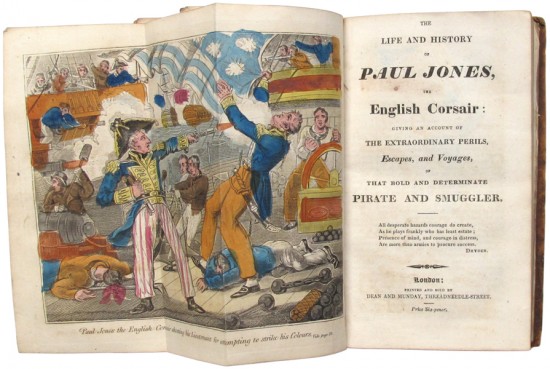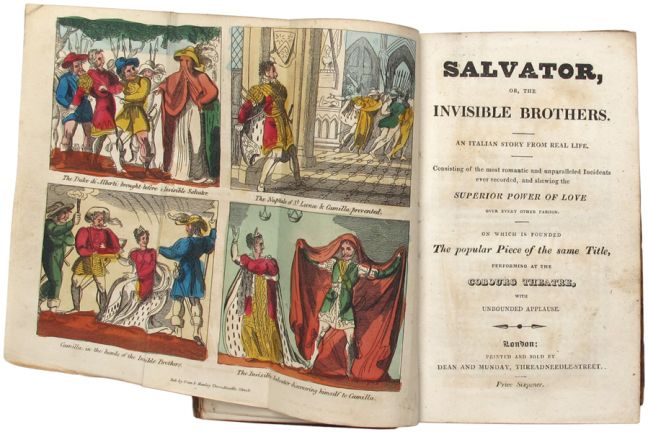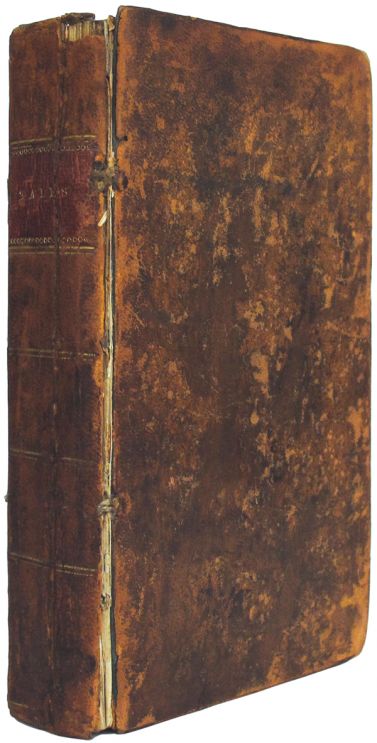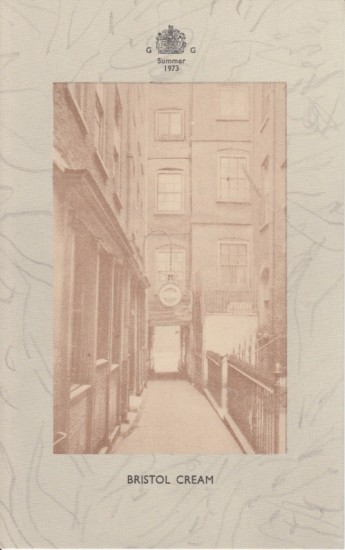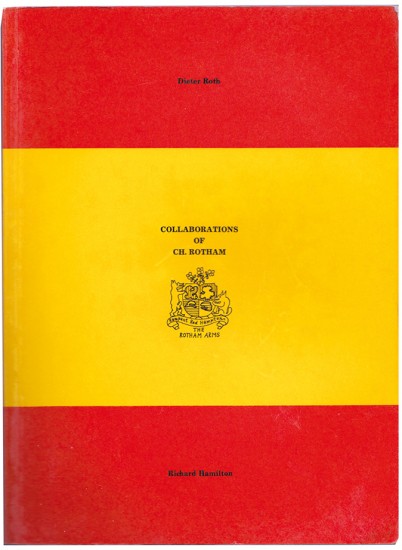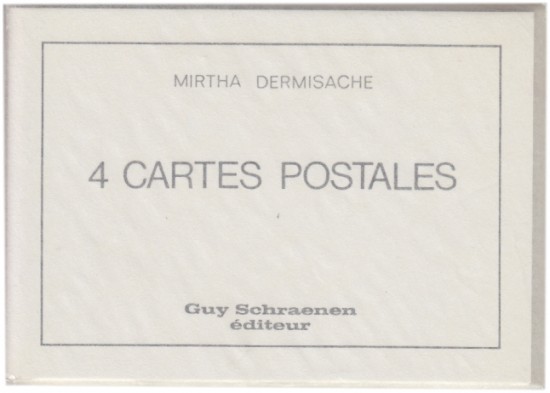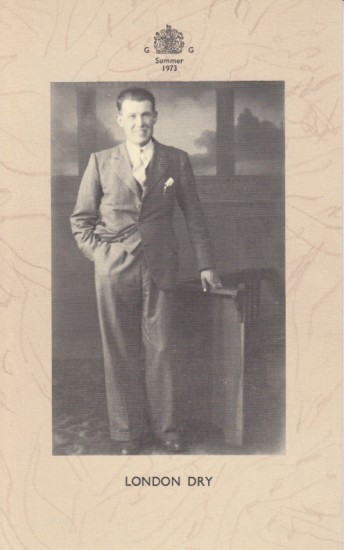'TALES': A Collection of Seventeen Sixpenny Shockers or Gothic Bluebooks
Lewis, Matthew 'Monk', Sarah Scudgell Wilkinson, J. W. H. Payne, An Etonian, et al
London. Hodgson & Co. / Dean & Munday / J. Bailey. c.1820
Sold
A rare survival: an unsophisticated contemporary collection of Gothic bluebooks or Sixpenny Shockers.
With a basis in 17th and 18th century chap-books and deriving from the popularity of the Gothic novel, the Sixpenny Shocker (so called for its price of 6d. for roughly 32 pages as opposed to the Shilling Shocker of c.72 pages) was an extremely popular publishing phenomenon in the final years of the 18th and early years of the 19th centuries. Issued in fragile wrappers and with a hand-coloured engraved frontispiece (many of these frontispieces featured vignettes keyed to the text with the illustration deriving from contemporary theatrical histrionics), these works, also called Gothic bluebooks (despite their appearance in wrappers of various colours), were based on Radcliffean modes, the German schauerroman, as well as the works of 'Monk' Lewis, Walter Scott and Byron and featured Gothic, chivalric and sensational archetypes.
Often advertised as abridgements of longer Gothic works or prose versions of popular dramas, the Gothic bluebooks, usually with a long exegetic title, were aimed at the leisured as well as the literate poor, took massive liberties with plot, style, authorship and, indeed, authorisation. In the most part anonymous, the authorship - even when an author is credited - of these works can be misleading, but they are by no means solely the work of Grub Street. Several of the authors credited in this collection, notably 'Monk' Lewis and Sarah Scudgell Wilkinson were novelists of some repute and it is worth noting that the Whig reformer Lord John Russell wrote a Sixpenny Shocker ('The Nun of Arrouca') himself.
The works represented in this collection bear testament to many of the tropes of the Sixpenny Shocker. We have a work by 'Monk' Lewis, two works by 'An Etonian' (the Etonian Shelley was a voracious consumer by contemporary accounts), works after Byron and the 'Author of Waverley', three works by Sarah Scudgell Wilkinson (a Gothic novelist in her own right) and a work on the notorious pirate 'Paul Jones', the eponymous subject of many stories. The titles of the present works too, fulfill the Sixpenny Shocker criteria: most consist of two parts (e.g. 'Salvator,Or, the Invisible Brothers', 'The Ruffian Boy; Or, the Castle of Waldemar' and 'Midnight Horrors, Or, the Bandit's Daughter'). There are, of course, the titles alluding to antiquity, the decayed castle, the outcast, the betrayed nobleman, the distressed damsel, the exotic and most other facets of plot that would be characterised as cliché. Present too, are four works with the exegetic titles précising the contents of the work and making a reading almost unnecessary.
The popularity of these works ('the Gothic chapbook passed from hand to hand and was literally read to pieces', Montague Summers) and the cheap and flimsy nature of their production has ensured their rarity (it has also been suggested that this rarity is due to the fact that they were used as a cheap source of lavatory paper) and many of the works in this volume survive in only a small number of examples. Of the seventeen works in the present volume, almost all are of the utmost rarity and are traceable in only a handful of copies in specialist collections, while one ('The Fortunes of Nigel') features in no UK or North American collection.
A full list of works with bibliographic details is available on request.
'No wonder that with pacing and tension so well orchestrated, many of these tales were read to pieces, and that those which survive are among the rarest of bibliographic curiosities.' (Alison Millbank, Gothic Satires, Histories and Chap-books).
'Although Mrs. Radcliffe continued to be widely read, admired, and imitated as the Nineteenth Century began, the route of development taken by the Gothic novel after 1800 was down the corridor of an unrestrained supernatural and toward the absolute horror of horrors. Hasty and relentless horror became the stock-in-trade of the Gothic chapbooks and bluebooks after 1800 when the main path for Gothic fiction was mapped out by Monk Lewis, not Ann Radcliffe. These hundreds of small Gothics were the cheap and tawdry offspring of the Schauerromantik engergies released by Lewis' The Monk.' (Frederick S. Frank, The First Gothics. A Critical Guide to the English Gothic Novel, pg. 433).
[PROVENANCE: Pencil ownership signature of Alice Feilding to front pastedown].
With a basis in 17th and 18th century chap-books and deriving from the popularity of the Gothic novel, the Sixpenny Shocker (so called for its price of 6d. for roughly 32 pages as opposed to the Shilling Shocker of c.72 pages) was an extremely popular publishing phenomenon in the final years of the 18th and early years of the 19th centuries. Issued in fragile wrappers and with a hand-coloured engraved frontispiece (many of these frontispieces featured vignettes keyed to the text with the illustration deriving from contemporary theatrical histrionics), these works, also called Gothic bluebooks (despite their appearance in wrappers of various colours), were based on Radcliffean modes, the German schauerroman, as well as the works of 'Monk' Lewis, Walter Scott and Byron and featured Gothic, chivalric and sensational archetypes.
Often advertised as abridgements of longer Gothic works or prose versions of popular dramas, the Gothic bluebooks, usually with a long exegetic title, were aimed at the leisured as well as the literate poor, took massive liberties with plot, style, authorship and, indeed, authorisation. In the most part anonymous, the authorship - even when an author is credited - of these works can be misleading, but they are by no means solely the work of Grub Street. Several of the authors credited in this collection, notably 'Monk' Lewis and Sarah Scudgell Wilkinson were novelists of some repute and it is worth noting that the Whig reformer Lord John Russell wrote a Sixpenny Shocker ('The Nun of Arrouca') himself.
The works represented in this collection bear testament to many of the tropes of the Sixpenny Shocker. We have a work by 'Monk' Lewis, two works by 'An Etonian' (the Etonian Shelley was a voracious consumer by contemporary accounts), works after Byron and the 'Author of Waverley', three works by Sarah Scudgell Wilkinson (a Gothic novelist in her own right) and a work on the notorious pirate 'Paul Jones', the eponymous subject of many stories. The titles of the present works too, fulfill the Sixpenny Shocker criteria: most consist of two parts (e.g. 'Salvator,Or, the Invisible Brothers', 'The Ruffian Boy; Or, the Castle of Waldemar' and 'Midnight Horrors, Or, the Bandit's Daughter'). There are, of course, the titles alluding to antiquity, the decayed castle, the outcast, the betrayed nobleman, the distressed damsel, the exotic and most other facets of plot that would be characterised as cliché. Present too, are four works with the exegetic titles précising the contents of the work and making a reading almost unnecessary.
The popularity of these works ('the Gothic chapbook passed from hand to hand and was literally read to pieces', Montague Summers) and the cheap and flimsy nature of their production has ensured their rarity (it has also been suggested that this rarity is due to the fact that they were used as a cheap source of lavatory paper) and many of the works in this volume survive in only a small number of examples. Of the seventeen works in the present volume, almost all are of the utmost rarity and are traceable in only a handful of copies in specialist collections, while one ('The Fortunes of Nigel') features in no UK or North American collection.
A full list of works with bibliographic details is available on request.
'No wonder that with pacing and tension so well orchestrated, many of these tales were read to pieces, and that those which survive are among the rarest of bibliographic curiosities.' (Alison Millbank, Gothic Satires, Histories and Chap-books).
'Although Mrs. Radcliffe continued to be widely read, admired, and imitated as the Nineteenth Century began, the route of development taken by the Gothic novel after 1800 was down the corridor of an unrestrained supernatural and toward the absolute horror of horrors. Hasty and relentless horror became the stock-in-trade of the Gothic chapbooks and bluebooks after 1800 when the main path for Gothic fiction was mapped out by Monk Lewis, not Ann Radcliffe. These hundreds of small Gothics were the cheap and tawdry offspring of the Schauerromantik engergies released by Lewis' The Monk.' (Frederick S. Frank, The First Gothics. A Critical Guide to the English Gothic Novel, pg. 433).
[PROVENANCE: Pencil ownership signature of Alice Feilding to front pastedown].
Various paginations (pp. 24 - 54), many with list of advertisements to final text leaf verso or final leaf. 17 works in 1 vol. 12mo. (184 x 112 mm). Each work with hand-coloured engraved frontispiece, 10 folding, the majority unsigned and undated but keyed to the text and showing multiple vignettes from the tales, one plate by Isaac Cruikshank (signed 'I. R. C.'), one work with additional hand-coloured vignette to title. Full contemporary tree calf, spine with double gilt rules and red morocco title label with title 'TALES', blue speckled edges.
#40703
